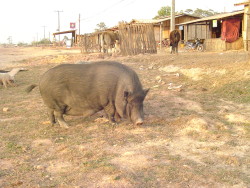
Photo. Nakai or not? Ask the pig. © Chris Tharp.
It wasn’t until it was after dark and a good twenty kilometers up the rough dirt road that I realized my mistake. The night before, around the campfire at the Travel Lodge, an American I met was loudly carrying on about his recent trip on The Loop. I was a bit drunk, more than exhausted, and not paying him the strict attention probably warranted.
“Once you get to the top of the plateau,” he said, “you’ll come to Nakai. Only the locals call it by another name. This happens a lot in Laos. The government has its official names, and the locals have theirs.”
So it was now dark and quite cold and I had overshot my town by over an hour. The next real settlement was at least sixty kilometers down a rocky and unforgiving stretch of road. I would have to turn back.
When I rode back into what I now thought to be Nakai, I was badly in need of some food, not to mention beer and a place to stay. I didn’t see any guesthouses in the town, though I had been told that there was one. What I did see, parked outside of a small restaurant, was a fully decked out 250cc Yamaha dirt bike. I quickly surmised that it did not belong to a local, most of whom prefer the small 100’s, like the one that was under me.
I parked my bike and walked into the restaurant and sat right down next to a Westerner decked out in dirt bike armor and typing away on an expensive-looking laptop. This was in place lit by a fluorescent light bulb with a dirt floor. The incongruity was stark, to say the least.
“Where’s Nakai?” I asked, not bothering to introduce myself.
“You’re in it, man. You’re here. Have a seat and grab a beer.”
His name was Don, and he was American. He was an expat, spending most of his time on his sailboat in Malaysia. Don was living the dream, of sorts, in that he had made enough money to pack it all up, wave goodbye to his friends, buy a boat, and sail halfway around the world. He was in his mid fifties and sported a dirty blond ponytail, which, with his dirt bike getup, took a good fifteen years off his appearance.
I ordered a beer and Don immediately set out to show me his state-of-the-art laptop. Using Bluetooth sattelite technology, Don was able to log on to the internet in the most undeveloped areas of Laos, in places where some people have never even seen a computer. But the real reason Don brought such equipment with him had little to do with email or checking his stocks: Don was making maps. He spent four months of the year motorcycling around Cambodia, Laos, and Vietnam, all the while filling in the details on satellite maps. Every village on every dirt track was meticulously plotted, within thirty foot accuracy, according to him. He claimed to have the most comprehensive and accurate map of Cambodia in existence. He said that he had “finished” the country.
This was Don’s hobby, and he was passionate about it. He told me that it cost him a lot of money and time, and that he hoped to one day financially profit from it. But I could tell that money wasn’t a huge concern for Don, despite that fact that he kept bemoaning the weakness of the dollar versus the strength of the Thai baht.
But soon the coversation switched form cartography to my my own foolhardy quest. He shook his head and laughed.
“You’re gonna try to make it down the rest of this road, all the way to Lak Sao, on a 100cc scooter? You’ll never make it man! I’d turn my ass back if I was you.”
“I know I can do it. These little bikes are tougher than you may think,” I replied. I owned one back in Korea, where I lived, and it served me well.
“Listen man – that road is a construction zone. This dam project is a big deal, it’s being financed by the World Bank. The road is nothing but potholes and rocks and dirt and dump trucks roaring by every thirty seconds. And that guide book is telling backpackers to come ride up here? They’re out of their fucking minds.”
We let it rest at that and after a hearty dinner of rice, soup, and some sort of fried meat (Beef? Buffalo? Cat?), Don and I drank a couple more beers, and then he showed me the way to the guesthouse, a sprawling complex around the corner from the restaurant that was mainly being used to house workers on the dam project. I got a room and fell into a deep night’s sleep.
Day 2
When I left the guesthouse in the morning, Don’s bike was already gone. He was probably halfway to the Vietnamese border, mapping dried riverbeds and counting chickens. I was hungry, so I stopped at a restaurant with a sign in English, usually a strong hint that their menu will be in the same tongue. I was lucky - I could indeed read the menu, so I ordered a bowl of noodle soup that did not take two hours to get to my table. It came right away, actually, as did the two cups of thick Lao coffee that charged me up for an uncertain day’s ride.
Day two on The Loop started like day one, with breathtaking scenery, a happy motorbike, and the full body thrill that always comes with cruising down the road in an exotic country. I passed through more rice paddies and thick forests. The trees cast their cool shadows over the road and the truck traffic was minimal. The morning sun warmed my back and everything was bright and good.
Of course this bliss was doomed to end, and it did so abruptly, in the form of a large rock in the middle of the road. Crack! My back tire hit it with full force, blasting out all of the air and kicking the rock straight up into the chain, which responded by jumping the sprocket. In less than a second, my peaceful morning cruise was transformed into a roadside stall-out in the middle of nowhere. So I did what I had learned to do the day before in such situations: I pushed.
Within ten minutes I was pushing the bike into a small village called Ban Nongboham. The area was dotted with these villages, clusters of wooden huts with thatch roofs, surrounded by fields with crops. All of the buildings were built on stilts – the rainy season was evidently serious business in these parts. As I strained into the village, I came across an open-faced hut with a woman inside. In front of her was one dusty counter with a smattering of goods for sale – a few cans of orange Fanta, some pink rolls of toilet paper, bottles containing gasoline, and unidentifiable foodstuffs packed in plastic wrappers (Nuts? Dates? Insects?). The woman smiled and greeted me loudly with the all-purpose Lao greeting:
“Sabaidee!”
“Sabaidee!” I replied, as I always did. At every village I rode through, the people - adult and child alike - would briefly stop what they were doing, wave, and hit me with their best shout-out.
The woman immediately followed her greeting with a litany of Lao, a language that I could only say “hello” and “thank you” in. She seemed unconcerned with my incomprehension. Surely any foreigner who would ride a motorcycle into this part of the country would be at least semi-facile in the language, she seemed to assume.
I just pointed to the tire and then pointed to the chain, shaking my head as to indicate a problem. She understood at once, and shouted to a dirty-faced little boy who meekly took us in from the other side of the road. She then motioned to the little boy and told me to follow him. Even though I didn’t understand the words, the intent was clear, and for a moment I convinced myself that I could actually understand the language, a self-delusion that I commonly fall into when confused in Asia.
I followed the little boy deeper into the village, past a line of huts. Hairy black pigs rooted in the dirt. Chickens of all ages clucked and ran in terror as I approached. Trash littered the ground, along with half burnt pieces of wood and dried cakes of cow shit. This village was poor. It lacked both running water and electricity. It also seemed to lack men, as the only people observing me were women, the younger of whom held infants to their breasts. It then occurred to me that the men were probably out in the fields – either that or they had recently been rounded up by government troops, taken to a deep part of the forest, and shot. I began to harbor serious doubts that my motorbike could be fixed. These doubts were soon assuaged, however, by the arrival of The Mechanic.
This article continues in part 4.
Chris Tharp, 26 August 2007
Additional information
Presentation of the author:
Chris Tharp is a former actor, comedian, and playwright from Seattle, Washington. He currently lives in South Korea, where he teaches at Busan Kyungsan College. He spends his spare time writing, fishing, playing music, motorcycling, performing, hiking, drinking, and eating still-moving seafood, though not necessarily in that order. Check out his blog: http://www.livejournal.com/users/tharp42
Information about Laos:
Laos is officially called the Lao People's Democratic Republic. The country is a landlocked communist state in southeast Asia, bordered by Myanmar (Burma) and China to the northwest, Vietnam to the east, Cambodia to the south, and Thailand to the west.
As Lonely Planet describes it on its website (www.LonelyPlanet.com): Snaking rivers, lush jungle, hectic markets and the UNESCO-listed Plain of Jars. Lonely Planet considers Laos as the highlight of Southeast Asia.
Laos traces its history to the Kingdom of Lan Xang or Land of a Million Elephants, which existed from the fourteenth to the eighteenth century. After a period as a French protectorate, it gained independence in 1949. A long civil war ended when the communist Pathet Lao movement came to power in 1975.












